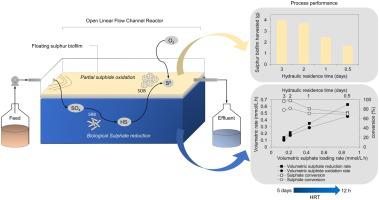当前位置:
X-MOL 学术
›
Biochem. Eng. J.
›
论文详情
Our official English website, www.x-mol.net, welcomes your feedback! (Note: you will need to create a separate account there.)
Effect of hydraulic residence time on biological sulphate reduction and elemental sulphur recovery in a single-stage hybrid linear flow channel reactor
Biochemical Engineering Journal ( IF 3.9 ) Pub Date : 2020-10-01 , DOI: 10.1016/j.bej.2020.107717 T.S. Marais , R.J. Huddy , S.T.L. Harrison , R.P. van Hille
Biochemical Engineering Journal ( IF 3.9 ) Pub Date : 2020-10-01 , DOI: 10.1016/j.bej.2020.107717 T.S. Marais , R.J. Huddy , S.T.L. Harrison , R.P. van Hille

|
Abstract Biological sulphate reduction and partial sulphide oxidation, occurring simultaneously within the hybrid linear flow channel reactor (LFCR) were evaluated, under controlled conditions at laboratory scale, as a function of hydraulic residence time (HRT) using a synthetic media containing 1 g/L sulphate. The hybrid LFCR comprises a rectangular channel containing carbon microfibers as a support matrix for attachment of sulphate-reducing bacteria and an exposed air-liquid interface to facilitate the formation of a floating sulphur biofilm. Exposure to decreasing HRT, from 3 days to 12 h, resulted in an increase in the volumetric sulphate reduction rate (0.14 to 0.63 mmol/L.h), achieving levels typically associated with active reactors. Sulphate conversion was highest (97 %) at a 3 day HRT, decreasing to 73 % at 12 h. The highest sulphide removal efficiency (82 %) and accompanying sulphur recovery through harvesting of the floating sulphur biofilm (FSB) was observed at a 2 day HRT. The sulphur fraction not recovered through the biofilm was predominantly released within the effluent as colloidal elemental sulphur and fragments of the sulphur-rich biofilm, with minimal re-oxidation to sulphate occurring in the reactor. The hybrid LFCR technology was able to achieve high rates of sulphate reduction and effective sulphide removal within a single, semi-passive reactor unit.
中文翻译:

水力停留时间对单级混合线性流道反应器中生物硫酸盐还原和元素硫回收的影响
摘要 使用含 1 g/L 的合成介质,在实验室规模的受控条件下,对同时发生在混合线性流道反应器 (LFCR) 中的生物硫酸盐还原和部分硫化物氧化作为水力停留时间 (HRT) 的函数进行了评估。硫酸盐。混合 LFCR 包括一个矩形通道,其中包含碳微纤维作为支撑基质,用于附着硫酸盐还原菌和暴露的气液界面,以促进漂浮的硫生物膜的形成。暴露于降低的 HRT(从 3 天到 12 小时)导致硫酸盐体积还原率增加(0.14 到 0.63 mmol/Lh),达到通常与活性反应器相关的水平。硫酸盐转化率在 3 天 HRT 时最高 (97 %),在 12 小时时降至 73 %。在 2 天的 HRT 时观察到最高的硫化物去除效率 (82%) 和伴随的通过收集漂浮硫生物膜 (FSB) 的硫回收。未通过生物膜回收的硫部分主要作为胶体元素硫和富硫生物膜的碎片在流出物中释放,在反应器中发生的再氧化为硫酸盐的情况极少。混合 LFCR 技术能够在单个半被动反应器单元内实现高速率的硫酸盐还原和有效的硫化物去除。未通过生物膜回收的硫部分主要作为胶体元素硫和富硫生物膜的碎片在流出物中释放,在反应器中发生的再氧化为硫酸盐的情况极少。混合 LFCR 技术能够在单个半被动反应器单元内实现高速率的硫酸盐还原和有效的硫化物去除。未通过生物膜回收的硫部分主要作为胶体元素硫和富硫生物膜的碎片在流出物中释放,在反应器中发生的再氧化为硫酸盐的情况极少。混合 LFCR 技术能够在单个半被动反应器单元内实现高速率的硫酸盐还原和有效的硫化物去除。
更新日期:2020-10-01
中文翻译:

水力停留时间对单级混合线性流道反应器中生物硫酸盐还原和元素硫回收的影响
摘要 使用含 1 g/L 的合成介质,在实验室规模的受控条件下,对同时发生在混合线性流道反应器 (LFCR) 中的生物硫酸盐还原和部分硫化物氧化作为水力停留时间 (HRT) 的函数进行了评估。硫酸盐。混合 LFCR 包括一个矩形通道,其中包含碳微纤维作为支撑基质,用于附着硫酸盐还原菌和暴露的气液界面,以促进漂浮的硫生物膜的形成。暴露于降低的 HRT(从 3 天到 12 小时)导致硫酸盐体积还原率增加(0.14 到 0.63 mmol/Lh),达到通常与活性反应器相关的水平。硫酸盐转化率在 3 天 HRT 时最高 (97 %),在 12 小时时降至 73 %。在 2 天的 HRT 时观察到最高的硫化物去除效率 (82%) 和伴随的通过收集漂浮硫生物膜 (FSB) 的硫回收。未通过生物膜回收的硫部分主要作为胶体元素硫和富硫生物膜的碎片在流出物中释放,在反应器中发生的再氧化为硫酸盐的情况极少。混合 LFCR 技术能够在单个半被动反应器单元内实现高速率的硫酸盐还原和有效的硫化物去除。未通过生物膜回收的硫部分主要作为胶体元素硫和富硫生物膜的碎片在流出物中释放,在反应器中发生的再氧化为硫酸盐的情况极少。混合 LFCR 技术能够在单个半被动反应器单元内实现高速率的硫酸盐还原和有效的硫化物去除。未通过生物膜回收的硫部分主要作为胶体元素硫和富硫生物膜的碎片在流出物中释放,在反应器中发生的再氧化为硫酸盐的情况极少。混合 LFCR 技术能够在单个半被动反应器单元内实现高速率的硫酸盐还原和有效的硫化物去除。



























 京公网安备 11010802027423号
京公网安备 11010802027423号